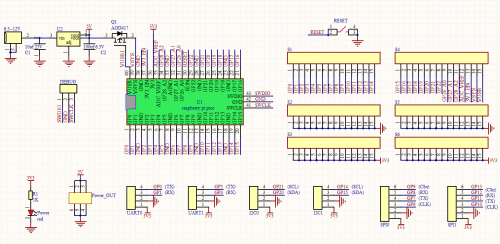KS3017 Keyestudio Raspberry Pico IO Shield: Difference between revisions
Jump to navigation
Jump to search
Keyestudio (talk | contribs) (Created blank page) |
Keyestudio (talk | contribs) No edit summary |
||
| (One intermediate revision by the same user not shown) | |||
| Line 1: | Line 1: | ||
== Description == | |||
The Raspberry Pico IO shield is designed for the Raspberry Pi Pico development board, without soldering. It also incorporates communications ports like 2 x I2C, 2 x UART, 2 x SPI, 3 x analog IO and 13 x digital IO as well as a 6.5-12V power interface. The integrated Lego position holes can assist to wire up multiple sensors or modules, which exceedingly increase more functions | |||
== Parameters == | |||
* Power supply: 5V | |||
* Output current: ≦500mA | |||
* DC input voltage: 6.5-12V | |||
* Output voltage: DC3.3V\5V | |||
* Recommended ambient temperature: -10°C ~ 50°C | |||
* Size:45.339MM *83.617MM | |||
* Spacing of pin headers: 2.54mm | |||
== Schematic Diagram == | |||
<br>[[Image:图片1265434646.png|500px|frameless]]<br> | |||
== Pins == | |||
* Digital IO x 13:GP2, GP3, GP12 ~ GP22 | |||
* Analog IO x 3: GP26, GP27, GP28 | |||
* UART x 2: UART0, UART1 | |||
* I2C x 2: I2C0, I2C1 | |||
* SPI x 2: SPI0, SPI1 | |||
* Power interface: 6.5 - 12V | |||
* GPIO pins, are used for the RP2040 chip of the Pico development board, as shown below; | |||
* GPIO29: for ADC mode(ADC3) measure VSYS/3 | |||
* GPIO25: connected to LEDs of users | |||
* GPIO24: VBUS sensing-if VBUS exists, it is the high level, in contrast, it is the ow level | |||
* GPIO23: on-board SMPS chip control pin | |||
* In addition to 26 GPIO pins(GP0~GP22, GP26_A0, GP27_A1, GP28_A2) and 7 GND pins, the Pico board has 7 physic pins as follows | |||
* PIN40: VBUS(5V) | |||
* PIN39: VSYS(2~5V) | |||
* PIN37: 3V3_EN(on-board SMPS chip Enable) | |||
* PIN36: 3V3(3.3V) | |||
* PIN35: ADC_VREF(ADC) | |||
* PIN33: AGND(analog) | |||
* PIN30: RUN(boot/forbid Pico) | |||
Latest revision as of 08:17, 30 December 2021
Description
The Raspberry Pico IO shield is designed for the Raspberry Pi Pico development board, without soldering. It also incorporates communications ports like 2 x I2C, 2 x UART, 2 x SPI, 3 x analog IO and 13 x digital IO as well as a 6.5-12V power interface. The integrated Lego position holes can assist to wire up multiple sensors or modules, which exceedingly increase more functions
Parameters
- Power supply: 5V
- Output current: ≦500mA
- DC input voltage: 6.5-12V
- Output voltage: DC3.3V\5V
- Recommended ambient temperature: -10°C ~ 50°C
- Size:45.339MM *83.617MM
- Spacing of pin headers: 2.54mm
Schematic Diagram
Pins
- Digital IO x 13:GP2, GP3, GP12 ~ GP22
- Analog IO x 3: GP26, GP27, GP28
- UART x 2: UART0, UART1
- I2C x 2: I2C0, I2C1
- SPI x 2: SPI0, SPI1
- Power interface: 6.5 - 12V
- GPIO pins, are used for the RP2040 chip of the Pico development board, as shown below;
- GPIO29: for ADC mode(ADC3) measure VSYS/3
- GPIO25: connected to LEDs of users
- GPIO24: VBUS sensing-if VBUS exists, it is the high level, in contrast, it is the ow level
- GPIO23: on-board SMPS chip control pin
- In addition to 26 GPIO pins(GP0~GP22, GP26_A0, GP27_A1, GP28_A2) and 7 GND pins, the Pico board has 7 physic pins as follows
- PIN40: VBUS(5V)
- PIN39: VSYS(2~5V)
- PIN37: 3V3_EN(on-board SMPS chip Enable)
- PIN36: 3V3(3.3V)
- PIN35: ADC_VREF(ADC)
- PIN33: AGND(analog)
- PIN30: RUN(boot/forbid Pico)
